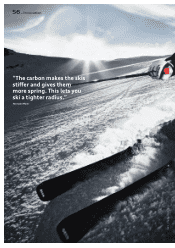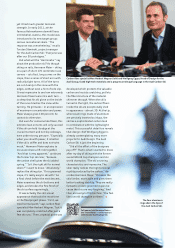Audi 2011 Annual Report Download - page 56
Download and view the complete annual report
Please find page 56 of the 2011 Audi annual report below. You can navigate through the pages in the report by either clicking on the pages listed below, or by using the keyword search tool below to find specific information within the annual report.
Innovation _
53
Technical Development in
Ingolstadt is hard at work on the
next generations of vehicles. The
VSC, for example, supports the entire
development process of a new model,
from design to construction of the
prototype and the pre-series phase
to the start of series production.
This
support applies not just to the product
itself, but also to the materials and
technologies used as well as the work
processes that are required later for
series production of the vehicles.
“The shortened communications
paths enable the optimal networking
of all departments involved in vehicle
construction,” explains Josef Habla.
Roughly 850 employees work in the
high-tech Ingolstadt facility, which
was opened in 2008. They are all
highly motivated, because they have
the opportunity to be involved in all
the latest developments and to take a
peek into the future.
The VSC helps the Audi engineers
to break new ground in many cases.
Even complex development processes
can be managed more eff ectively. For
instance, the experience gleaned from
the A1 e-tron fl eet trial launched
in 2011 can fl ow directly into
further development. “Such parallel
developments would no longer
even be possible with a classic test
workshop,” says Heinz Hollerweger.
It is becoming increasingly
important to fi ne-tune the individual
vehicle components to one another at
the start of the development process.
That’s because the technologies will be
more intermeshed in the future than
is the case today. Electrifi cation of
the drivetrain, for example, presents
new challenges for the body structure
that must be considered in the
design and the selection of materials.
The Audi brand has long had a core
competence in this regard that plays a
decisive role for the car of the future:
lightweight construction. Since 1994,
the Company has produced around
700,000 vehicles with the Audi Space
Frame (ASF) – both all-aluminum and
hybrid aluminum structures – and
demonstrated its expertise in large-
scale lightweight construction in the
process. In the current model lineup,
the A8 luxury sedan and the R8 high-
performance sports car represent
the ASF principle in its purest form.
The body of the TT compact sports
car is a hybrid aluminum and steel
construction, and the bodies of the
A7 Sportback and the new A6 include
a large proportion of aluminum in
addition to steel. The Audi engineers
are convinced that the new Audi Space
Frame of multimaterial construction,
in which components of aluminum,
steel and carbon fi ber-reinforced
polymers are joined together, is
the right approach for the future of
volume vehicle production. At Audi,
lightweight construction does not
mean concentrating on one material,
but rather working intelligently and
fl exibly with a variety of materials.
“The aim is to use the smallest amount
of material possible in the ideal place
to achieve the best performance,”
explains Peter Fromm, “in a way that
is suitable for volume production.”
Audi pools the know-how required
to do this under the term “ultra.” The
intent is to make the vehicles more
agile while reducing fuel consumption
and, in the case of electric mobility,
off setting the weight disadvantage
Around 1,800 people worldwide
work in the Audi Group’s
pre-series center workshops
and offi ces, including some 850
employees in Ingolstadt. The
32,500 square meter, fi ve-story
facility is dedicated to optimizing
the quality and effi ciency of the
development processes for new
automobiles and technologies.
This unique organizational form
enables products and processes
to be verifi ed earlier than ever
before. In the “Cave,” for example,
the feasibility of prototypes can
be verifi ed as early as the initial
concept phase of a product
using
virtual reality techniques. The
design status of the automobile
develops in parallel with prototype
construction. With virtual reality,
the construction of the automobile
can be systematically simulated
long before the fi rst vehicle is
built. This allows problems to be
identifi ed and resolved early on,
and production workfl ows to be
designed even more effi ciently.
Audi
Pre-Series Center
(VSC)
Optimal networking
In the future, the
technologies will be
even more intermeshed
than is the case today.
PHOTOS | ENNO KAPITZA
Electric mobility in a captivating design: The Audi R8 e-tron
will take to the streets as a limited series in late 2012.
























